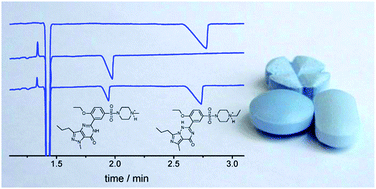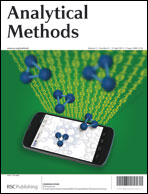Determination of sildenafil and vardenafil by capillary zone electrophoresis using capacitively coupled contactless conductivity detection
Abstract
A method based on capillary electrophoresis with capacitively coupled contactless conductivity detection (CE-C4D) for determination of two important phosphodiesterase type-5 inhibitors (sildenafil and vardenafil) is introduced. The background electrolyte (BGE) consisted of an aqueous solution of 500 mmol L−1 acetic acid, and the capillary was previously treated with polybrene solution to prevent cationic analytes from adsorbing onto the inner surface. Although the analytes migrate in the counter flow, the total time is short. An instrument with two C4D detectors allowed a seamless transition from a fast method (less than one minute) but of low-efficiency using the first detector to a more efficient method using the second detector. The analysis of commercial tablets showed no significant difference between CE-C4D and HPLC methods. Conductivity detection is a well-known low selectivity detection scheme, which in conjunction with the high mobility of the co-ion in the BGE (hydroxonium) allows one to predict that other cationic analogues of sildenafil can also be detected. This is an interesting feature given the increasing number of compounds in this class.


 Please wait while we load your content...
Please wait while we load your content...